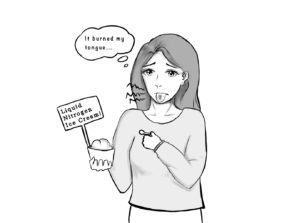
On Aug. 30, the U.S. Food and Drug Administration released a formal safety alert regarding the consumption of foods that are prepared or served with liquid nitrogen.
Liquid nitrogen is the highly cooled and condensed form of gaseous nitrogen which is found in more than 75 percent of the atmosphere. This colorless, flavorless chemical is used in various applications. If mishandled or prepared incorrectly, liquid nitrogen in some foods, such as the Instagram famous “Dragon’s Breath” cereal snack, can cause serious bodily harm.
“Liquid nitrogen, although non-toxic, can cause severe damage to skin and internal organs if mishandled or accidentally ingested due to the extremely low temperatures it can maintain,” the FDA said in a safety alert. “The FDA has become aware of severe—and in some cases, life-threatening—injuries, such as damage to skin and internal organs caused by liquid nitrogen still present in the food or drink.”
“Liquid nitrogen, although non-toxic, can cause severe damage to skin and internal organs if mishandled or accidently ingested”
Nitrogen’s sudden boiling can result in lung and stomach burstings.
“[Nitrogen] will turn from liquid to gas at -196 degrees Celsius,” said Chemistry and Biotechnology teacher Leigh-Anne Ecklund. “It can expand very rapidly [in room temperatures] … [and] just explode.”
As the rapidly expanding vaporous nitrogen displaces oxygen, people with difficulty breathing can suffer from shortness of breath and exhaustion. In the safety advisory, the FDA added that “consumption may also cause breathing difficulty, especially among individuals with asthma.”
In ice cream, nitrogen’s extremely cold temperatures can burn tongues and scar mouths. If liquid nitrogen comes in direct contact with skin or tissue, serious injuries can occur. If one ingests liquid nitrogen, his body tissue could freeze rapidly, burning his stomach or throat and causing frostbite. As the water in skin cells freeze, blisters and pain can erupt in the affected areas.
“[When] veins and arteries and capillaries … freeze, they becomes like shards of glass… ruptur[ing] tissue,” Ecklund said.
Such damage to the circulatory system can stop the blood flow to affected cells and in the most extreme cases result in internal bleeding. Shattered capillaries are not dangerous; however, vein and artery damage can be life threatening.
The health concern mainly sprouts from “mishandling” of the dangerous chemical. As long as all liquid nitrogen has evaporated from the food, and is not served at extremely cold temperatures, the FDA states that it “do[es] not pose a significant risk of injury.” Restaurants that serve these frozen foods must be careful to allow the nitrogen to evaporate before serving their customers. Fortunately, many desserts and snacks offered, like “Dragon’s Breath,” are prepared with only small amounts of liquid nitrogen, which in most cases evaporates quickly enough to pose little threat.

Students have mixed responses to the possible dangers of liquid nitrogen in foods. Some students express little concern over liquid nitrogen.
“[The liquid nitrogen was an] entertaining aspect to the food,” said sophomore Shoryoung Gong. “Nothing bad really happened.”
However, other students are more concerned. Sophomore Jona Nakai is worried about the potential side effects of liquid nitrogen.
“I might die or get injured because of [liquid nitrogen],” Nakai said. “It needs to be prevented.”
Despite the government’s warnings of liquid nitrogen’s harm, customers do not have much control of their food safety.
“I’ll just make sure that the people prepared it correctly,” said senior Melissa Zuno-Garcia, “[but that is] pretty much impossible.”
Due to liquid nitrogen’s potential harm, companies are now setting regulations in order to reduce the risk of injury. Praxair, a company with California locations that sells liquid nitrogen, requires a license to buy the chemical.
“In order to get them to sell it to you, you need to prove you’re with a learning institution,” Ecklund said.
No new policy of the chemical’s use has been released by the FDA since its initial warning. As long as pre-existing regulations are effective, diners stay cautious and preparations are safe, lovers of these trendy desserts can keep their cool.
